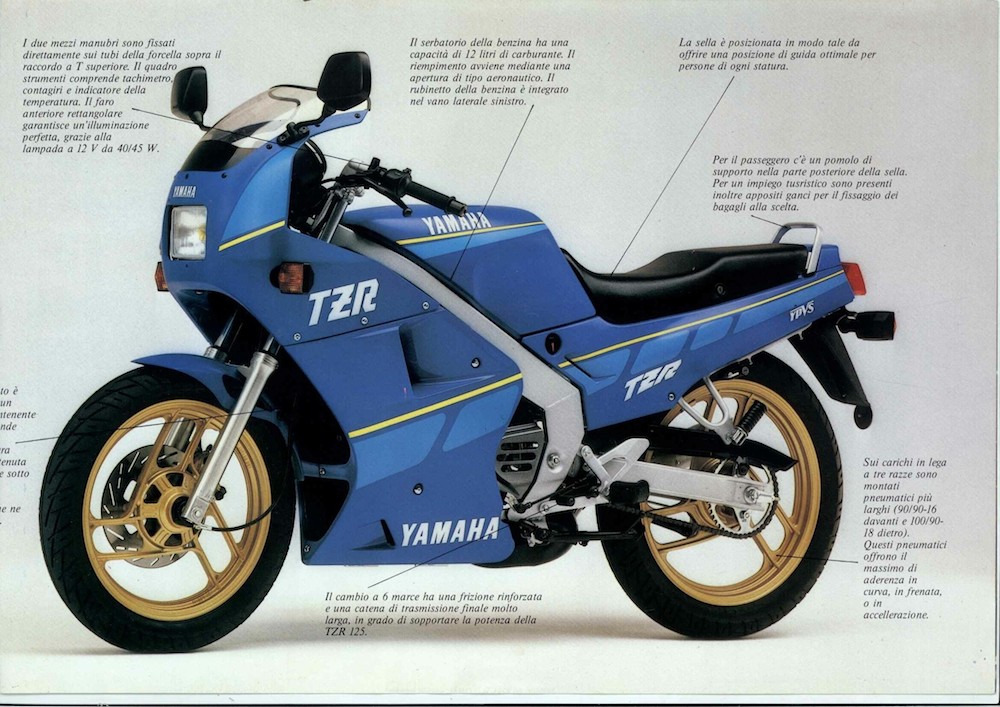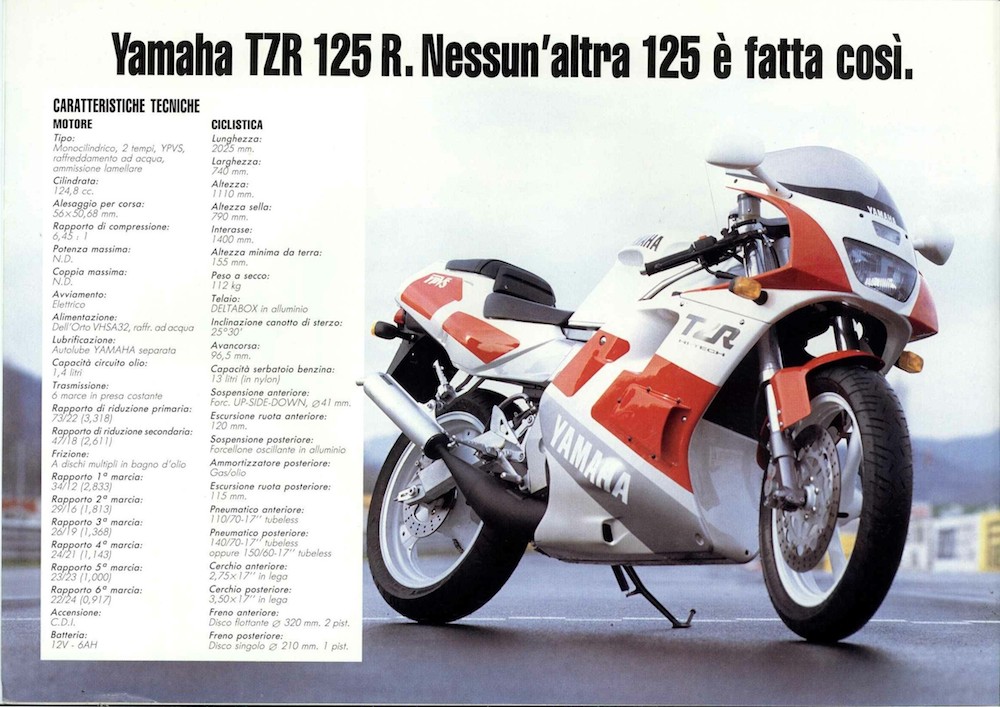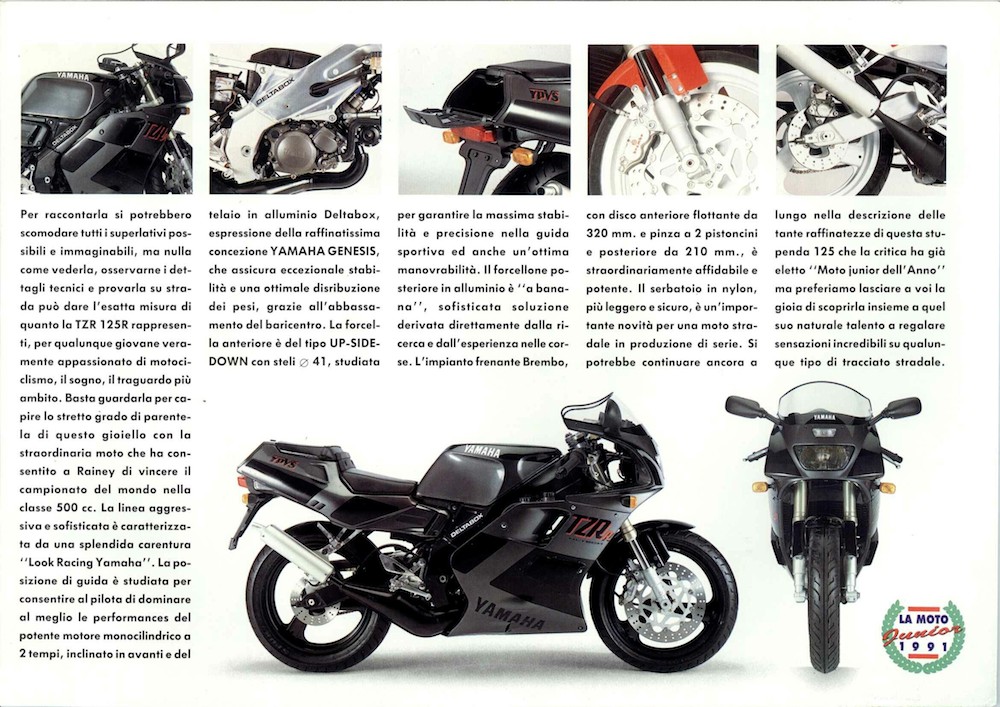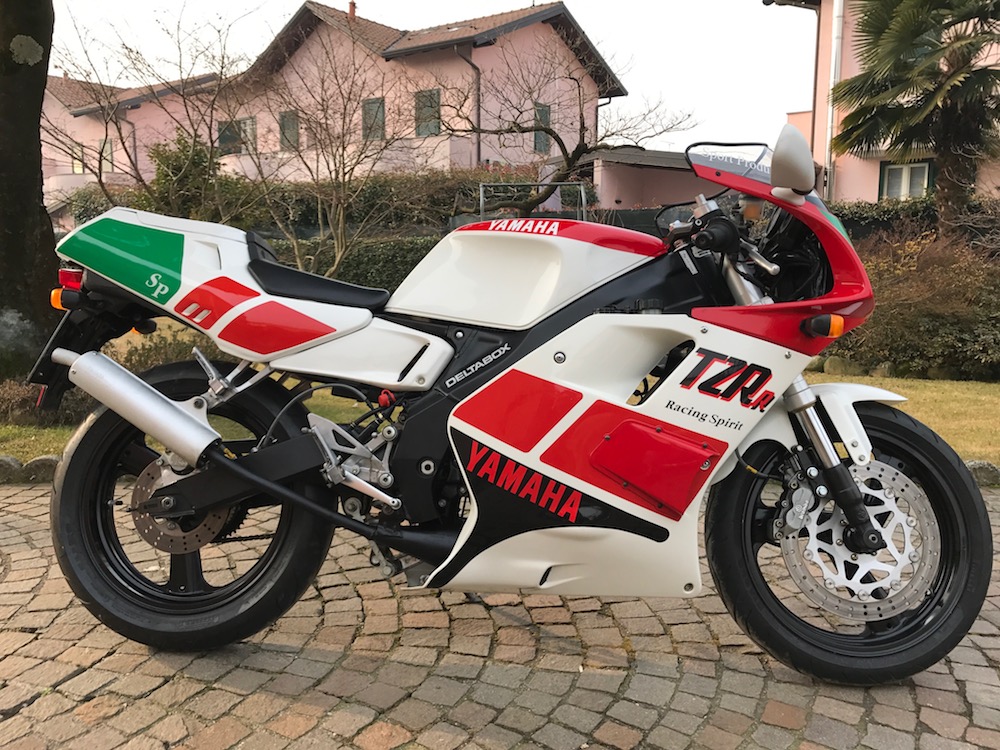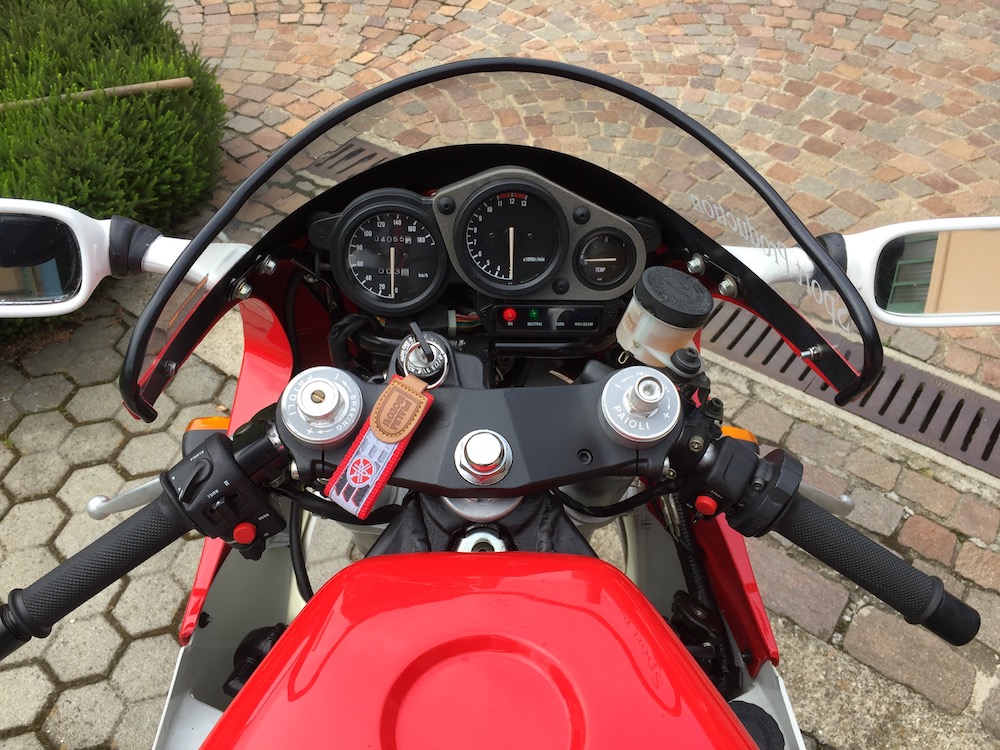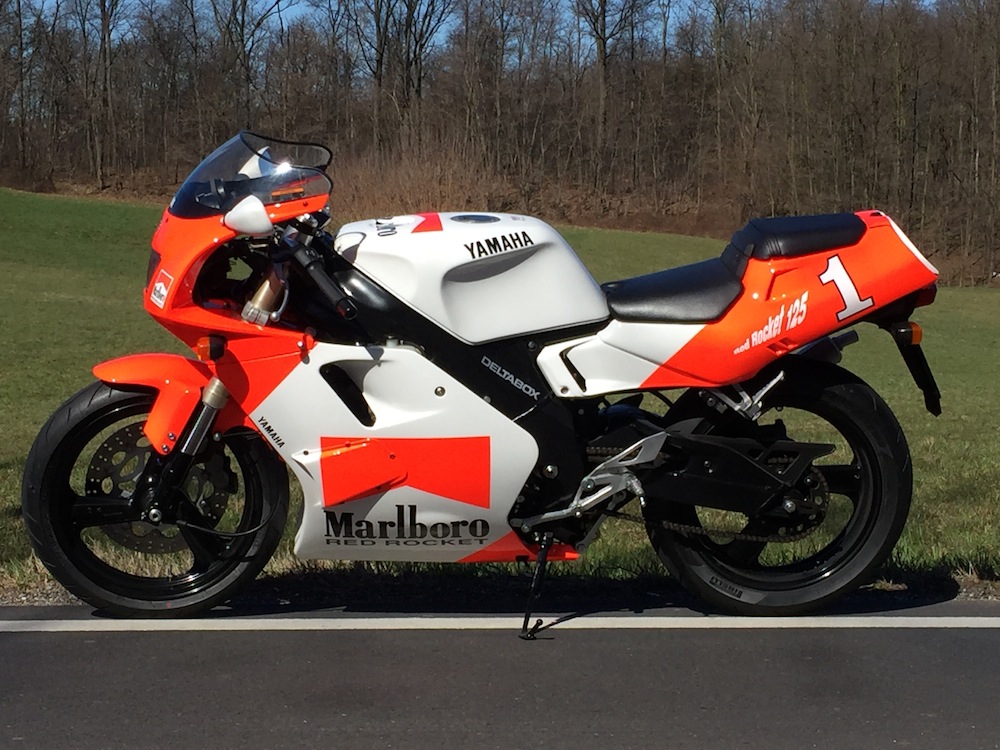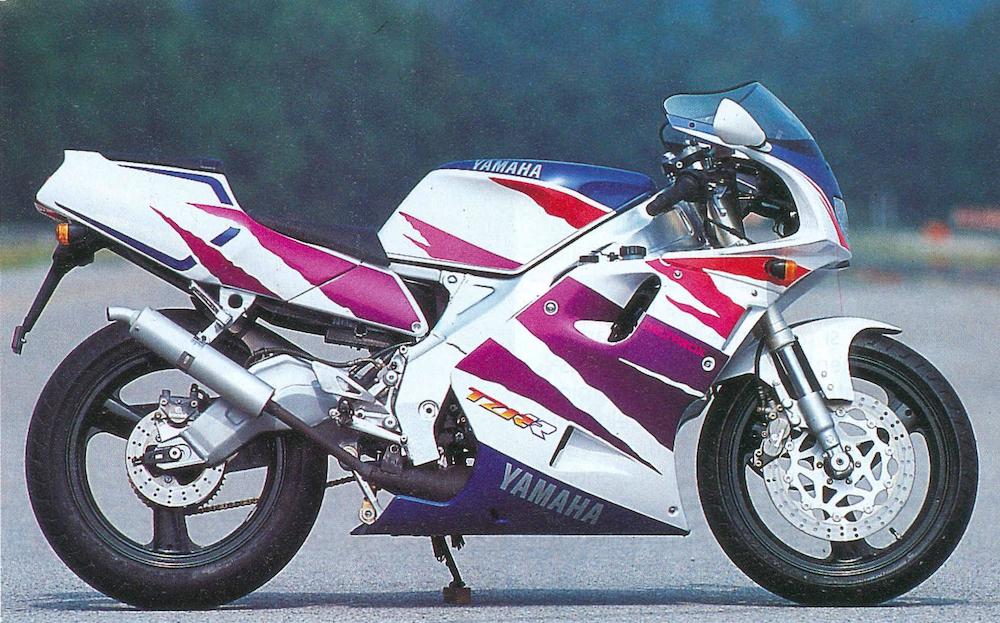Un episodio, quello delle 125 stradali made by Yamaha Belgarda, durato solo nei primi anni 90, ma molto intenso. Delle “altre case” impegnate nel settore delle 125 stradali, Yamaha è infatti quella che ha avuto più successo. Non solo la produzione di 125 stradali voluta dall’importatore italiano Yamaha Belgarda fu di ottima qualità ed ottenne importanti risultati commerciali, ma venne estesa a tutto campo anche al settore delle enduro dove i modelli Yamaha furono lo stesso molto apprezzati con le versioni TDR. Yamaha fu comunque attiva nel settore delle 125 stradali già dal 1988 con la TZR prodotta in Spagna e dal 1985 con la DT 125 da enduro.
Ecco i modelli prodotti:
TZR 125 (1988-1990) – tipo 3FN
Presentata al salone di Parigi del 1987 e commercializzata in Italia a partire dall’Aprile 1988, la nuova TZR, tipo 3FN, rappresenta un’eccezione nel panorama delle 125 stradali nostrane. Difatti la nuova piccola della casa di Iwata non è prodotta in Italia, bensì in Spagna dall’importatore spagnolo S.E.M.S.A. (Sociedad Espanola de Motocicletas S.a.) su licenza Yamaha.
Con una dotazione tecnica soddisfacente che comprende anche la valvola allo scarico a controllo elettronico, la TZR però non è paragonabile al meglio della produzione 1988 di Aprilia, Cagiva, Gilera e Honda Italia.
La TZR è, infatti, una moto dall’aspetto piuttosto economico con particolari come le ruote di piccole dimensioni più adatte ad un cinquantino, il freno posteriore a tamburo e la mancanza dell’ormai indispensabile avviamento elettrico che la rendono una moto meno appetibile della concorrenza.
Per scelta progettuale, la TZR è quindi una moto volutamente poco pretenziosa. Ma nel 1988 per conquistare il mercato italiano ci vuole ben altro ed infatti a Belgarda, sede dell’importatore italiano di Yamaha, già si pensa ad una nuova TZR made in Italy che vedrà la luce nel 1991.
Il prezzo nel 1988 è di Lire 4.181.60 ed i colori disponibili sono bianco/rosso e azzurro/giallo. Nel corso del 1989 viene introdotta una seconda versione dotata di disco freno posteriore e nuove ruote a tre razze.
La tipo 3FN adotta DGM 52486.
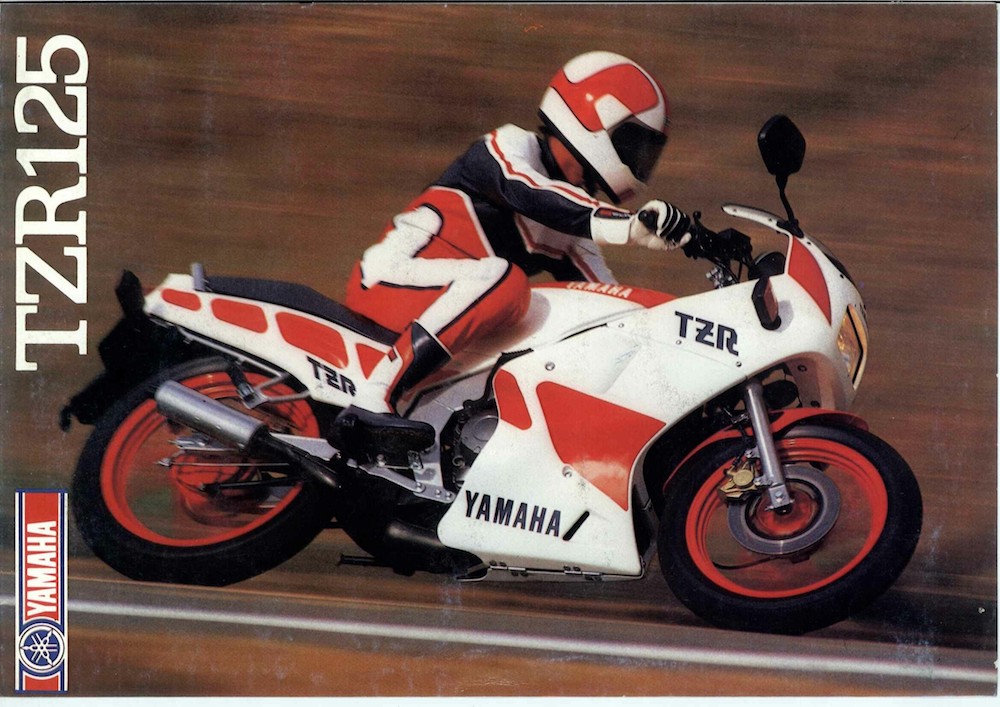
La moto in breve
La linea della nuova TZR è ispirata alla bella TZR 250 e grazie alle colorazioni adottate risulta anche molto elegante e ben equilibrata.
La carena dotata di due belle prese d’aria laterali giova al telaio Deltabox in acciaio che da bella mostra di se. Il cupolino squadrato ospita un faro rettangolare che concede poco alla moda del momento che preferisce i doppi fari. Il serbatoio con tanto di tappo areonautico ed il codino si itegrano perfettamente con la struttura.
Di aspetto economico gli specchietti e gli indicatori di direzione. La sella asportabile lascia spazio al serbatoio dell’olio e ad un mini-vano per gli attrezzi di bordo. La batteria si trova dietro al fiachetto destro.
La completa strumentazione ed i comandi elettrici sono ben fatti e sono di produzione giapponese.
Ciclistica
Il telaio della TZR è un doppio trave laterale Deltabox scatolato in acciaio di bell’aspetto, sebbene non curato come le altre 125 nostrane. Nel particolare il telaietto reggi sella saldato direttamente al telaio principale ed il forcellone in acciaio di esile aspetto lasciano molto a desiderare.
Le forcelle sono di produzione Yamaha e hanno steli di solo 33 mm, mentre la sospensione posteriore non progressiva vanta un ammortizzatore sempre di produzione Yamaha e regolabile nel precarico molla.
L’impianto frenante prevede l’adozione di un onesto disco fisso anteriore da 245 mm servito da pinza a monopistoncino e di un semplice tamburo posteriore da 130 mm.
Le ruote in lega a tre razze hanno le rispettive dimensioni di: anteriore 90/100-16 e posteriore 100/90-18.
Il peso rilevato è di 119 kg.
Motore
Il propulsore della TZR ha sicuramente preso spunto dalla grande esperienza Yamaha nel settore dei 2 tempi stradali e da competizione. Vanta, infatti, la valvola allo scarico YPVS (Yamaha Power Valve System) con tanto di servomotore elettrico controllato elettronicamente, l’ammissione lamellare nel carter ed il contralbero anti vibrazioni che rendono giustizia a questo motore che può vantare molte caratteristiche tecniche simili ai suoi concorrenti. Sebbene pronto all’avviamento con il kick-start è un vero peccato i tecnici Yamaha non lo abbiano dotato di avviamento elettrico.
Il gruppo termico ha un diagramma di funzionamento che tende a privilegiare l’elasticità di marcia e la ripresa piuttosto che la potenza massima e ovviamente anche l’impianto di scarico ed la taratura del carburatore Mikuni VM 26 SS sono anch’essi ottimizzati per questo scopo.
Non sorprende quindi che la potenza massima rilevata alla ruota sia di 23,94 cv a 10250 giri e la velocità massima di 148,9 km/h, ovvero prestazioni ampiamente superate dalle concorrenti italiane. Nelle prove di ripresa sui 400 metri da 50 km/h, la TZR registra un tempo di 19,6 sec ed una velocità di uscita di 97,8 km/h, ovvero un prestazione decisamente buona e molto migliore di tante concorrenti a conferma delle doti turistiche di questo motore.
TZR-R 125 – 1991 – tipo 4DL (TZR 125 R)
Presentata al Motor Show di Bologna nel Dicembre 1990 e commercializzata in Italia solo dall’estate 1991, la TZR-R, tipo 4DL, è un bel passo avanti rispetto alla sua progenitrice TZR 3FN prodotta negli stabilimenti spagnoli della Yamaha.
Innanzitutto la nuova TZR-R è ora una moto italiana a tutti gli effetti ed al pari della concorrente NSR prodotta dalla Honda Italia. La paternità dell’intero progetto TZR-Rè della Belgarda (importatrice in Italia delle moto Yamaha) che ha sapientemente miscelato la componentistica italiana con quella giapponese creando una moto ex-novo rispetto alla versione precedente e ora dotata anche di un italianissimo propulsore Minarelli prodotto su specifiche Yamaha.
Il prezzo nel 1991: Lire 6.555.100 ed i colori disponibili sono: bianco/rosso con telaio lucidato e cerchi bianchi e (dal 1992) anche in grigio/nero con telaio nero e cerchi neri. A fine 1991 viene presentata anche una versione dedicata al campionato Sport Production e dotata di sospensioni regolabili e molte altre migliorie. (vedi sotto). Nel 1993 si aggiunge la colorazione “Red Rocket” Marlboro Replica che riprende l’impostazione delle TZR “normali”.
La TZR-R rimane in produzione fino al 1994 quando verrà sostituita dalla TZR-RR. Secondo fonti Yamaha, sono state prodotte tra il 1991 ed il 1995 un totale di 9877 Yamaha Belgrado 4DL (in tutte le versioni e quindi compresa la SP).
Il codice omologativo è OM 53202. Su tutte le 4DL il numero telaio ed il numero motore sono esattamente gli stessi.
La moto in breve
La Belgarda ha saputo sviluppare una linea convincente e decisamente riuscita che caratterizza immediatamente la nuova TZR dandole un tocco di sportività e di eleganza al tempo stesso.
La splendida carenatura lascia in bella vista nuovo telaio Deltabox in alluminio ed il cupolino di generose dimensioni adotta una soluzione originale per il proiettore anteriore che è ora di forma trapezoidale con la luce di posizione separata.
Il serbatoio ed il codone vanno ad integrarsi perfettamente con la struttura e degna di nota è la presenza di un pratico e alquanto capiente vano portaoggetti ricavato nel codone e chiuso da uno sportello protetto da serratura. Decisamente una rarità su una 125 sportiva!
Da notare la pratica disposizione del rubinetto della benzina, del comando dello starter e dei vari serbatoi per l’olio di miscelazione e per il liquido di raffreddamento collocati ai lati all’interno della carenatura e quindi di immediato accesso.
I comandi a pedale e le pedane sono in alluminio e la cura dei particolari e degli assemblaggi è decisamente buona con una verniciatura ben eseguita e con gli adesivi protetti da trasparente.
La completa strumentazione di ottima fattura ed i comandi elettrici sono di produzione giapponese.
Ciclistica
La TZR-R adotta una ciclistica ex-novo rispetto alla versione precedente e vanta un livello di rifinitura veramente lodevole. Difatti, laddove la precedente TZR montava un economico Deltabox in acciaio, la nuova TZR-R ora adotta un telaio in alluminio riprogettato completamente e con il motore ancorato alla struttura principale priva di culla inferiore. Il telaietto reggisella è ora imbullonato alla struttura principale, ben realizzato ed anch’esso in alluminio. Il forcellone posteriore con braccio destro a banana è anch’esso ottimamente rifinito ed in alluminio.
L’interasse di 1400 mm caratterizza la TZR essendo il più ampio della categoria. Una scelta che rende la TZR meno maneggevole delle concorrenti, ma più stabile nei curvoni veloci.
Le sospensioni vedono l’adozione di una imponente forcella Paioli a steli rovesciati da 41 mm e una nuova sospensione posteriore progressiva e dotata di ammortizzatore regolabile nel precarico molla.
Anche i freni sono completamente riprogettati e sono ora di produzione Brembo. All’anteriore troviamo un disco freno flottante da 320 mm servito da pinza a quattro pistoncini ed al posteriore un disco fisso da 210 mm servito da pinza a pistoncino singolo.
Le ruote in lega leggera a tre razze hanno le seguenti dimensioni: 110/70-17 anteriore e 140/70-17 posteriore.
Il peso totale rilevato a secco è di 130 kg.
Motore
Il propulsore della TZR-R è un moderno ed italianissimo Minarelli prodotto su specifiche Yamaha. Il cilindro reca la scritta (sul lato sinistro) 3MB-00.
Tra le peculiarità del propulsore Minarelli, ricordiamo: valvola YPVS (Yamaha Power Valve System) allo scarico comandata da servomotore elettrico a controllo elettronico, ammissione lamellare nel carter e contralbero anti-vibrazioni.
A differenza del suo predecessore pensato per privilegiare l’elasticità di marcia piuttosto che la potenza pura, il propulsore Minarelli ha un carattere tutt’altro che pacifico.
Il gruppo termico, l’impianto di scarico ed il nuovo carburatore Dell’Orto VHSA 32 sono pensati per la ricerca della potenza massima, rilevata in 32,15 cv alla ruota a 11500 giri (23,94 cv a 10250 giri la TZR). La velocità massima cresce al ragguardevole valore di 169 km/h (148.9 km/h la TZR).
A causa della rapportatura troppo distesa delle utlime marce ed al temperamento molto sportivo del motore che non ama girare troppo in basso, nelle prove di ripresa sui 400 metri da 50 km/h, la TZR-R registra un tempo di 20,5 sec ed una velocità di uscita di 91,3 km/h (19,6 e 97,8 km/h la TZR)
TZR R-SP 125 – 1992 – tipo 4DL (TZR 125 SP)
Presentata nel 1992, la TZR-SP nasce per fornire una moto più competitiva a coloro che vogliono partecipare al campionato italiano Sport Production, dove però Yamaha dovrà accontentarsi di poco, visto che Aprilia, Cagiva e Honda dettano legge con moto più competitive in pista.
Posta in vendita ad un prezzo di Lire 7.199.500 (praticamente 1 milione in più che la normale R) e solo i colorazione bianco/rosso con cerchi neri e telaio verniciato di nero, la SP viene venduta come omologata per la circolazione stradale. Non siamo a conoscenza di una numerazione particolare per il telaio o su quante SP siano state effettivamente prodotte.
Il tipo è sempre 4DL, ma sul libretto di circolazione compare la scritta BELGARDA 4DL YAMAHA TZR 125 SP. Il DGM 53202 rimane il medesimo per le 4DL normali, ma guadagna la nuova estensione EST 02 OM.
La numerazione di telaio segue un ordine particolare che caratterizza la versione SP, ovvero 4DL-050101. Il numero “0” posto dopo il numero “05”, identifica quindi la SP da una TZR normale. Pertanto, a titolo di esempio, la numero di telaio 050125, risulterà essere la 25esima TZR-SP prodotta. Secondo una nostra ricerca, in Italia sono state immatricolate 95 TZR SP con numerazione compresa tra 100 e 195. Il numero di motore deve essere lo stesso del telaio, quindi nell’esempio precedente, 050125 sarà anche il numero di serie del motore.
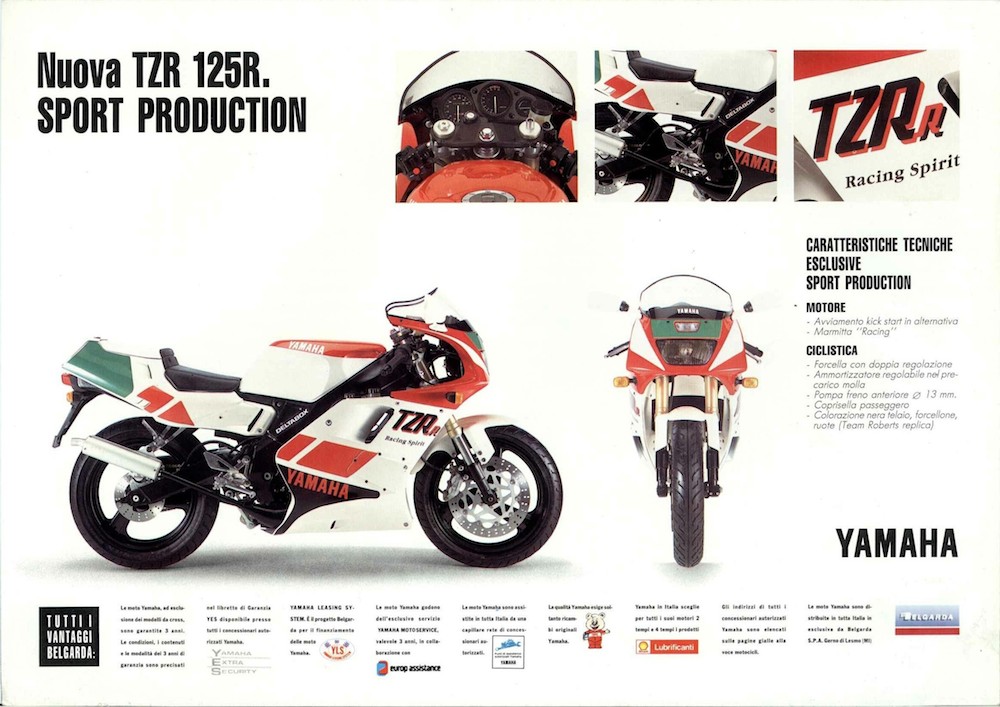
Le differenze fra R e SP sono le seguenti:
- Colorazione SP caratterizzata da tabelle porta numero verdi e da coprisella passeggero. (la SP viene venduta anche con il kit per montare l’avviamento a pedale).
- Le modifiche alla ciclistica prevedono una forcella rovesciata Paioli sempre da 41 mm come per la R normale, ma ampiamente tarabile nell’idraulica in compressione ed in rilascio. Al posteriore viene adottato un nuovo ammortizzatore sempre Paioli, tuttavia sempre regolabile solo nel precarico molla. La pompa freno anteriore è ora di 13 mm ø.
- Cilindro Gilardoni specifico per la SP marchiato (sulla sinistra) 4DL-00.
- Pistone specifico per la SP.
- Testata specifica per la SP in due pezzi.
- Carter motore lavorati con ammissione lamellare specifica per la SP (il pacco lamellare della versione normale non è adattabile)
- Centralina CDI, valvola allo scarico YPVS e servomotore specifici per la SP.
- Scarico con un’espansione più corta ed uno “spillo” terminale più lungo e specifico per la SP (marchiato Lanfranconi)
- Rapportatura finale e seconda e terza marcia più ravvicinate.
Viene mantenuto il carburatore Dell’Orto VHSA da 32 mm della R che ovviamente deve essere sostituito per un 28 mm qualora la moto venisse utilizzata in gara per il campionato SP. L’airbox è specifico per la SP (sono presenti due manicotti sul dorso della cassa filtro) e naturalmente i settaggi per il carburatore sono specifici per la SP.
Come spesso accade per le versioni SP, la TZR SP è una moto particolare, quasi artigianale. Pertanto, non di rado, durante il corso della produzione alcune SP potevano lasciare la catena di montaggio con alcuni particolare, come cilindri (sempre marchiati DL-00) e scarichi (Figaroli al posto del Lanfranconi) più performanti. Esistono anche numerose altre modifiche, come ad esempio l’accensione a rotore interno, ed è complicato trarre una lista completa ed aggiornata di che cosa era effettivamente disponibile. Per assicurarsi che il motore sia SP, l’importante è che il numero di serie corrisponda esattamente al numero di telaio. Altrimenti si potrebbe incorrere in motori non SP o di rotazione, ovvero montati per sostituire il blocco motore originale come spesso avviene per le moto con un passato agonistico.
Le modifiche adottate sulla SP rendono la TZR una moto migliore. Infatti, non solo il motore gode di un apprezzabile miglioramento nella parte alta del contagiri con un allungo migliore, ma gode di un’erogazione anche più fluida migliore rispetto alla R che invece soffre ai bassi regimi. La diversa rapportatura del cambio rende la SP migliore anche in accelerazione e ripresa rispetto alla R.
Le prestazioni rilevate sono di 33,02 cv a 11500 giri per una velocità massima di 174,5 km/h.
TZR-R 125 Red Rocket – 1993 – tipo 4DL (TZR 125 R)
La TZR nella colorazione più bella. Una vera replica della 500 da Granpremio di Wayne Rainey. La Red Rocket rimane praticamente invariata rispetto alla versione precedente. La Red Rocket non è una versione SP e pertanto non riceve la più performate e raffinata componentistica della versione SP. La Red Rocket si caratterizza dalle altre TZR per il telaio rigorosamente verniciato di nero (stessa tonalità e vernice della TZR-R nera), ma soprattutto per i piedi forcella che solamente sulla Red Rocket sono in color nero. Vengono solamente adottati aggiornamenti di produzione, tra i quali spicca una nuova carburazione ed un silent-block aggiuntivo su una rivista culla reggi-motore per contenere maggiormente le vibrazioni.
Numero di telaio e numero di motore devono essere “matching numbers”, cioè gli stessi.
Il tipo è sempre 4DL ed il DGM 53202.
TZR-RR 125 – 1994 – tipo 4DL (TZR 125 RR)
Commercializzata a partire dal 1994, la nuova TZR-RR rappresenta un aggiornamento della precedente TZR-R. Come per la sua progenitrice, la RR è frutto della collaborazione tra la Yamaha ed i tecnici della Belgarda e della Minarelli che costruisce il motore su specifiche giapponesi.
Il prezzo nel 1994 è di Lire 7.180.000. Il codice tipo è sempre Yamaha Belgarda 4DL, ma guadagna il nuovo suffisso TZR 125 RR ed codice omologativo DGM 53202 guadagna la nuova estensione EST 03 OM.
Laddove la precedente versione rappresentava un netto passo avanti rispetto alla economica TZR del 1988, la nuova RR và a perfezionare i punti deboli riscontrati sulla precedente R.
Sotto il profilo tecnico, le modifiche apportate al propulsore Minarelli rendono il motore della RR migliore della precedente versione che soffriva rapporti del cambio troppo lunghi ed una erogazione della potenza piuttosto scorbutica e priva di allungo. Peccato che la RR perda il fascino di alcune soluzioni originali come il proiettore sdoppiato ed il cassettino porta-oggetti nel codone che caratterizzavano la versione precedente rispetto alla concorrenza.
Complice l’arrivo nel 1996 delle limitazioni a 15 cv e della superiorità delle Aprilia RS e Cagiva Mito EV, la RR non si dimostra un grande successo commerciale.
Le differenze rispetto alla TZR-R sono così riassumibili:
- Adozione di un nuovo cupolino e di un nuovo gruppo ottico unico a mandorla in luogo del precedente col la luce di posizione sdoppiata.
- Carena ridisegnata nelle prese d’aria, parafango anteriore dal profilo più snello e adozione di un parafango posteriore.
- Nuovo codone più rastremato e con la luce posteriore ora integrata. Tale modifica ha portato all’eliminazione del cassettino in plastica che sulla R dava accesso al porta-oggetti a cui ora si accede in modo convenzionale sollevando la sella.
- Adozione di una nuova sportiva sella pilota in poliuretano espanso e di nuovi supporti per le pedane passeggero.
- Telaio Deltabox in alluminio invariato rispetto alla R, ma ora proposto in alluminio lucidato.
- Adozione di un nuovo forcellone, sempre in alluminio, ma con braccio destro a banana.
- Nuovo impianto di scarico e cassa filtro aria ottimizzati per migliorare l’allungo ed il tiro ai medi regimi e rapportatura finale accorciata di quattro denti onde limitare il calo di giri tra i cambi di marcia.

